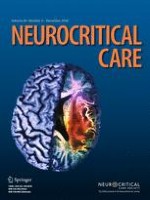Erschienen in:

08.06.2018 | Original Article
Clinical Correlates of Periodic Discharges and Nonconvulsive Seizures in Posterior Reversible Encephalopathy Syndrome (PRES)
verfasst von:
Laure Bastide, Benjamin Legros, Nishi Rampal, Emily J. Gilmore, Lawrence J. Hirsch, Nicolas Gaspard
Erschienen in:
Neurocritical Care
|
Ausgabe 3/2018
Einloggen, um Zugang zu erhalten
Abstract
Importance
The pathophysiological mechanisms of Posterior Reversible Encephalopathy Syndrome (PRES) and related seizures remain poorly understood. The prevalence and clinical significance of nonconvulsive seizures (NCSz) and related epileptiform patterns during continuous electroencephalography monitoring (CEEG) in PRES have not been well described.
Objective
To report the prevalence, characteristics and risk factors for NCSz and related highly epileptiform patterns in patients with PRES, and to determine their relation to imaging abnormalities and outcome.
Design, Setting and Participants
From a prospective CEEG database, we retrospectively identified patients with PRES and reviewed their medical charts. Based on CEEG findings, we designed a retrospective cohort study comparing two groups defined based on the presence or the absence of NCSz and/or periodic discharges (PDs).
Main outcomes and Measures
The prevalence and risk factors for PDs and NCSz, description of EEG and magnetic resonance imaging (MRI) abnormalities and functional outcome as measured by the Glasgow Outcome Scale (GOS) at hospital discharge.
Results
Among 37 eligible patients, 23 (62%) had PDs or NCSz. The presence of NCSz was associated with the presence of PDs (15/22 vs. 1/15; p = 0.0002). NCSz and PDs were usually either lateralized or bilateral independent and predominated in the posterior regions. No clinical features were associated with the occurrence of PDs or NCSz. Cortical restricted diffusion on MRI was more frequent in the PDs/NCSz group (17/23 vs. 1/14; p < 0.001). PDs/NCSz were associated with worse outcome, with 3 deaths vs. 0 in the no PDs/NCSz group and fewer cases with low disability (4 vs. 9 cases with GOS = 5, p < 0.04).
Conclusions and Relevance
Our results reveal a high prevalence of NCSz and PDs in critically ill patients with PRES and an association with restricted diffusion and worse outcome, whether treating or preventing these EEG findings can improve outcome requires further research.